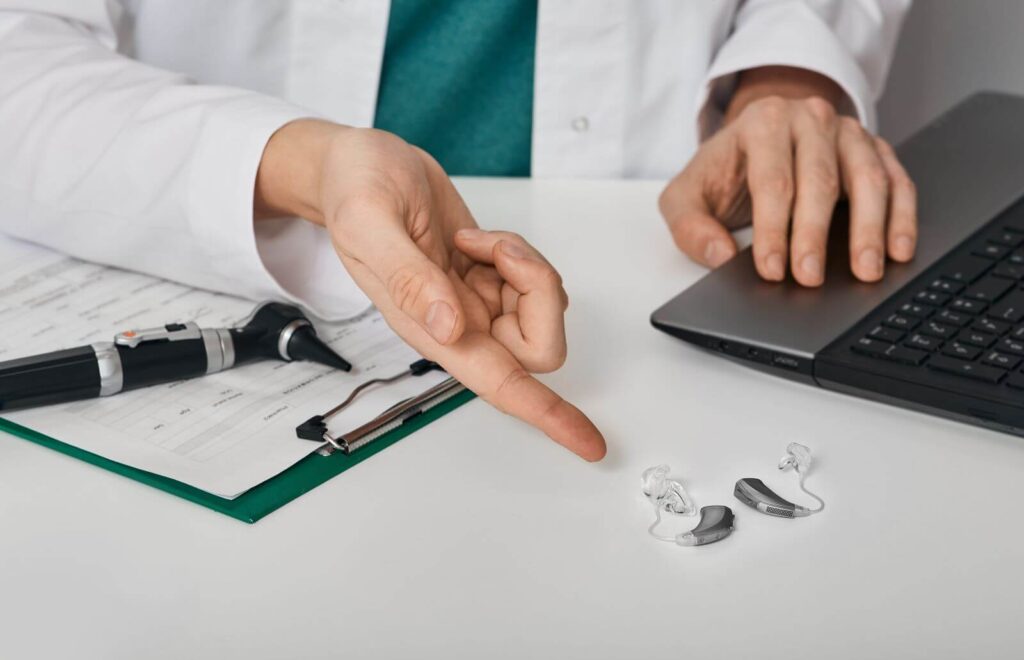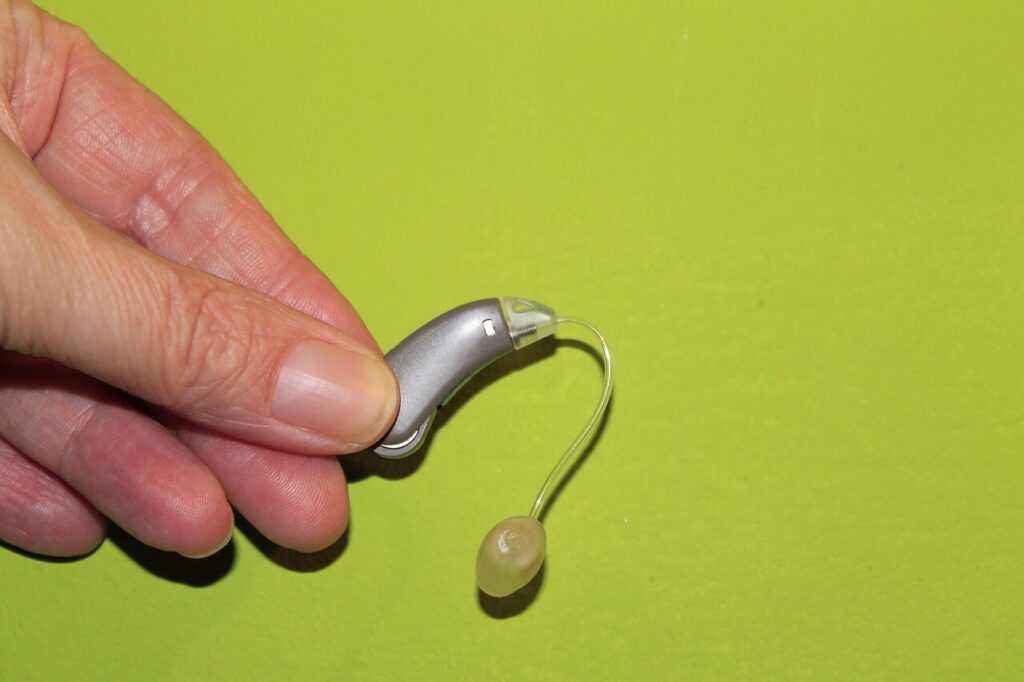Proper cleaning and care of your hearing aids is important for their sustained performance and overall lifespan. Consistent cleaning and maintenance routines are key in preventing the accumulation of ear wax, debris, and other contaminants that can compromise the functionality of your device. By adhering to recommended cleaning practices and utilising appropriate tools and solutions, you’ll ensure your device continues to function optimally.
Ear wax, moisture, and environmental particles can infiltrate the intricate components of your hearing aids. This diminishes sound quality and potentially leads to internal damage. Furthermore, accumulated wax and debris increase the risk of irritation and possible infection within the ear canal.
A thorough understanding of cleaning and maintenance protocols is indispensable for any hearing aid wearer.
Hearing Aid Components: Microphones, Speakers, and Batteries
Understanding the different parts of your hearing aids is the first step to keeping them clean and working right. Let’s break down a few key areas:
- Microphones: These tiny openings on your hearing aid are what “hear” the world around you. Earwax and dust can get stuck in them, making sounds muffled. Cleaning these regularly is super important for clear sound.
- Battery Compartment: This is where those little power packs go! Keeping this area clean helps your batteries work their best. Always check it for anything that looks weird, like rust.
- Batteries: Speaking of batteries, it’s gotta be said – fresh batteries keep your hearing aids humming along. Make sure you always change them when needed and put them in the right way to avoid any power problems.
- Speakers: This is where the amplified sound comes out, right into your ear. Keeping this part clean, without any wax or other stuff blocking it, will ensure that the sound quality stays top-notch.
Hearing Aid Cleaning Tools and Products
To clean your hearing aids like a pro, you’ll need the right tools for the job. Here’s the breakdown:
- Hearing Aid Cleaning Kit: These kits are a worthwhile investment and often include a little brush, a wax pick (or loop), and other goodies that let you thoroughly clean your devices. The brush helps remove loose debris and wax from the surface, while the wax pick or loop is perfect for getting into those nooks and crannies to clear out stubborn buildup.
- Specialised Cleaning Products: There are cleaners specifically made for hearing aids, designed to safely and effectively break down buildup on all those delicate parts. It’s really important to stick with the cleaning products recommended for your specific hearing aids to ensure they have a long and healthy life.
Having these tools and cleaners on hand will make the whole cleaning process a lot smoother and more effective. With them, you’ll be able to keep your hearing aids pristine and working flawlessly.
Safe Cleaning Agents and Substances to Avoid
When it comes to cleaning your hearing aids, choosing the right cleaning equipment is essential.
Forget about regular soapy water or any other household cleaners, unless your hearing aid maker specifically says it’s okay. Water and soap can sneak inside those tiny parts and cause problems with how they work.
Instead, go for a dry cloth to remove any ear wax or dirt accumulated throughout the day. However, remember to be gentle as these devices are delicate – just like your ears.
Wet wipes can be a no-no too. Sometimes they have harsh chemicals or too much moisture, which isn’t good for the electronics inside your hearing aids. If you do use wipes, make sure they’re the ones meant for hearing aids.
Hearing Aid Daily Cleaning & Maintenance Routine
Sticking to a daily cleaning and maintenance schedule for your hearing aids is key to keeping them in tip-top shape and working well for a long time.
Hear is a suggested routine:
- Start with a dry cloth or a soft brush to gently wipe down your hearing aids. This gets rid of any dust, earwax, or other stuff that might have built up during the day. Pay close attention to the microphone holes, battery area, and any spots where gunk likes to hang out.
- Check your batteries and pop in fresh ones if needed. Keeping those hearing aids powered up means they’ll always be ready to work their best for you.
Adding these simple things to your daily routine will really help your hearing aids last longer and give you the best hearing possible.
Step-by-Step Guide to Cleaning Your Hearing Aids
Cleaning your hearing aids properly is crucial for their maintenance and longevity. Follow this 8 step guide for cleaning your hearing aids:
- Start by turning off your device and removing the batteries.
- Use a soft cloth or a cleaning brush to gently wipe down the surface of the hearing aid, removing any debris or wax buildup.
- Pay special attention to the microphone openings, battery compartment, and other areas that may accumulate debris.
- Use a wax pick or loop to carefully remove any stubborn wax buildup from the openings and vents of the hearing aids.
- Clean the earmold or the part that fits inside your ear canal according to the manufacturer’s instructions. This may involve using specific cleaning solutions.
- Dry the hearing aids and earmold thoroughly with a soft cloth or allow them to air dry completely.
- Replace the batteries and ensure they are inserted correctly.
- Store your clean and dry hearing aids in a protective case or a hearing aid drying device.
Following this step-by-step guide will help you maintain the cleanliness and functionality of your hearing aids, ensuring that they provide you with the best hearing experience.
Tips for Effective Wax Removal
Wax buildup is a common issue for hearing aid users, as earwax can accumulate in the openings and vents of the device. Here are some tips for effective wax removal:
- Use a wax loop or pick to carefully remove the wax from the openings and vents of the hearing aid. Be gentle to avoid damaging the delicate components.
- Avoid using cotton swabs or other foreign objects to remove wax, as they can push the wax further into the device or damage the ear canal.
- Consider using hearing aids with wax guards or filters, which can help prevent wax from entering the internal components of the device.
- Regularly check and replace the wax guards or filters according to the manufacturer’s recommendations.
- If you experience excessive wax buildup, consult an audiologist for assistance and guidance on safe and effective wax removal techniques.
By following these tips, you can effectively remove wax and prevent wax-related issues in your hearing aids, ensuring optimal performance and longevity.
When to Seek Professional Help
While regular cleaning and maintenance can prevent many issues with your hearing aids, there may be times when professional help is necessary. Here are some situations when you should seek assistance from a hearing care professional:
- Persistent issues with your hearing aids, such as feedback, distortion, or volume problems, that cannot be resolved through troubleshooting.
- Damage to the hearing aids, such as broken components or physical trauma.
- Changes in your hearing or hearing aid performance that require adjustments or reprogramming.
- Questions or concerns about the proper use, care, or maintenance of your hearing aids.
- When it’s time for routine professional cleaning and maintenance, as recommended by your hearing care professional.
Don’t hesitate to reach out to a hearing care professional, audiologist, or hearing aid provider when you need expert assistance with your hearing aids. They have the knowledge and expertise to diagnose and resolve any issues you may encounter
Closing Thoughts
Regularly cleaning your hearing aids is essential for maintaining optimal performance and prolonging the lifespan of your device. Hearing aids, with proper cleaning and maintenance, can truly transform your daily life. They’re not just an investment in your hearing health, but also in your overall quality of life. So, isn’t it time you took control of your hearing health?
If you or a loved one is experiencing hearing issues, why not speak to one of our London based audiologists. We offer home visit hearing tests throughout the London area.


